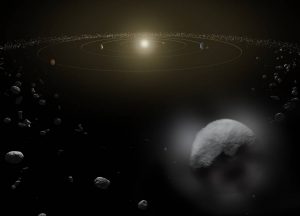What is a dwarf planet?
It caused quite a hoo-hah in 2006 when Pluto was demoted to a “dwarf planet”. In its pronouncement (Resolution 5A) the International Astronomical Union (IAU) agreed to define a planet as a celestial body that:

- is in orbit around the Sun;
- has sufficient mass for its self-gravity to overcome rigid body forces so that it assumes a hydrostatic equilibrium (nearly round) shape; and,
- has cleared the neighbourhood around its orbit.
The IAU Resolution also defined a “dwarf planet” as a celestial body that:
- is in orbit around the Sun;
- has sufficient mass for its self-gravity to overcome rigid body forces so that it assumes a hydrostatic equilibrium (nearly round) shape;
- has not cleared the neighbourhood around its orbit: and
- is not a satellite.
All other objects, except satellites, orbiting the Sun, determined the IAU, shall be referred to collectively as “Small Solar-System Bodies”. These exist in protoplanetary discs and debris discs and are believed to form out of cosmic dust grains.
But many scientists are still not happy. For one thing, since exoplanets do not orbit the sun then by definition they are not planets. As we shall see later, when talking about exoplanets, there are some very large bodies indeed and must surely have cleared their orbital neighbourhood. These sceptics also remark that in some instances even Earth and Neptune have not cleared their orbital paths entirely. So what are they?
These lot are probably still mumbling but the fact is Pluto is a dwarf planet and now has four more companions to prove it.
Pluto had already faced a demotion of sorts in 2005 when a “new planet” Eris was discovered and it was claimed at the time to be the larger object. There was even the suggestion that astronomers had found the tenth planet of the Solar System. However, Nasa’s New Horizons spacecraft reported back precise measurements to prove that Pluto was the larger body and therefore number one in the dwarf planet stakes. Since its discovery preceded Eris by over 70 years Pluto can also be given the honour of being the prototype.
Something else seems to be a feature of dwarf planets: very eccentric orbits. Pluto ticks this off too. With an aphelion of 7.38 billion kilometres and perihelion of 4.44 billion kilometres it has by far the most eccentric orbit compared to the eight planets of the Solar System.
The other four dwarf planets so far added to the list (as of January 2020) are: Ceres, Eris, Haumea and Makemake. Ceres trawls its way through the asteroid belt; the rest lie in the outer reaches of the Solar System in another field of small bodies called the Kuiper Belt. The IAU further determined that all these dwarf planets should be categorised as “plutoids”.
There are several other dwarf candidates under review such as Sedna and Quaoar.
In closing, it seems to me that the dividing line between a planet and a dwarf planet is simply a matter of gravity. We know from many studies that planets form from the accretion of materials and that such accretion occurs due to gravity. The mass of the body and again its gravity reaches a point where the materials spin into a sphere. So is it not just a question of orbital dominance? You get big, fat and round by clearing up your orbital path of neighbourhood material—what some authorities refer to as planetesimals. (Planetesimals are solid objects found in protoplanetary disks and debris discs). That makes you a planet. If you don’t do this then you are not a planet but instead, according to the IAU, you are either a “Plutoid” or a Small Solar System body.
The IAU and astronomers, in general, remain at loggerheads over the terminology. A Dwarf Planet may be variously referred to as a Plutino, a Trans-Neptunian Object (also written transneptunian object), a Kuiper Belt Object, Plutoid, and so on. None of these alternative terms is appropriate for Ceres. Yes, it is a dwarf planet, but it is in the Asteroid Belt!
A Trans-Neptunian object is, by definition, by the way, any minor planet or dwarf planet in the Solar System that orbits the Sun at a greater average distance than Neptune. If you come across the abbreviation TNO, same thing.
Back to Top
By Nigel Benetton, science fiction author of Red Moon Burning and The Wild Sands of Rotar
Last updated: Tuesday, 24th March 2020